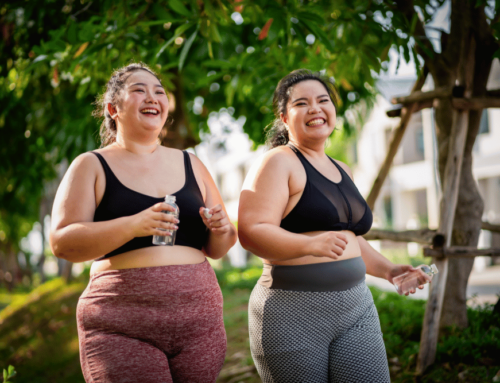
Note: This is the fourth in a five-part series on mindfulness and mindful eating.
In my second post in this five-part series, I talked about the benefits of mindfulness, and how mindfulness meditation is the most important practice to help you build your “mindfulness muscle.” In this post, I give you some tips and tools to start practicing mindfulness meditation on your own, or with some guidance.
Mindfulness meditation is at its heart a form of attention training. With regular practice, meditation makes it easier to return your attention where you want it to be. When learning how to meditate, an easy way to start is to simply sit and observe your breath, bringing your attention back to your breath whenever you notice your mind drifting—and it will!
Meditating on the breath
You may have noticed I said “observe your breath,” not “focus on your breath.” It’s all too easy for beginning meditators to find themselves fiercely concentrating on breathing in and out, possibly even to the point that their breathing falls out of its natural pattern.
(Now, there are some valuable breathing exercises that involve breathing in, holding the breath for a few counts, then breathing out for a certain number of counts, but that’s not what I’m talking about here.)
Probably the most helpful instruction I’ve heard in guided meditations is “Breathe, and know that you are breathing.” That’s it. Just breathe naturally, and when your attention wanders, bring it back, so you are once again aware that you are breathing. (How fortunate that we don’t have to be aware that we’re breathing in order to breathe at all!)

Body awareness meditation
You can also choose to focus on other sensations. For example, “Sit, and know that you are sitting.” This can feel very grounding on days when you feel like your mind is bouncing into the stratosphere.
Being aware of your feet on the floor and your butt in the chair (or on the meditation cushion) is like a mini-version of the body scan, which is another way to practice meditation, one that anyone who’s taken an Mindfulness-Based Stress Reduction (MBSR) course will be very familiar with. I won’t get into body scans here, but I do want to mention that this particular practice may not be appropriate for those who have a history of physical/sexual trauma, or who are struggling with an eating disorder. Working on embodiment is wonderful, but not if you aren’t ready for it yet.
If you are meditating, and you notice that a foot is falling asleep, or that you have an itch, or that a particular muscle seems tense, you can choose to shift your focus there and make that part of the meditation. If the sensation fades, then shift your attention back to the body breathing, or sitting. Similarly, You can shift your attention to the sound, but don’t get carried away thinking about the sound

Open awareness meditation
Another way to train your attention when meditating is to bring your awareness to the sounds around you — cars passing by, birds singing, the sound of the heater or air conditioner, voices outside or in the next room.
Again, there’s a difference between “awareness” and “focusing.” For example, it’s one thing to be aware of the presence of voices outside, another to focus on what the voices are saying, or start dwelling on how rude it is to talk so loudly!
You can also do this with vision, being aware of things in your line of sight — again, without focusing on any one thing. I like to do this when waiting for a train or bus, because I don’t look like I’m meditating. It’s like stealth meditation!
What to do when your mind wanders
Notice I said “when,” not “if.” Because your mind will wander and that is totally normal. When you notice that you have shifted into thinking mode instead of awareness-of-the-present-moment mode , softly say to yourself “thinking” and return your attention to where you intended it to be. Be kind, rewind.

Meditation misconceptions
One major misconception about meditation is that the goal is to empty the mind. Not only would that be impossible, but it’s totally not the point. What meditation and other forms of mindfulness practice can do is help you get to a point where you have your thoughts, but your thoughts don’t have you.
A common metaphor that I really like is the waterfall metaphor. Imagine that you are sitting behind a waterfall, and the water is the constant stream of thoughts that run through your head. You’re not caught up in your thoughts, you’re not being swept away by your thoughts, but you are able to notice and observe your thoughts.
Another misconception — and I can’t state this strongly enough, which is why I keep bringing it up — is that you’ve failed if your mind wanders. The reality is that we all have a constant stream of thoughts moving through our minds, and we are going to get hooked by some of those thoughts and carried away. Even experienced meditators notice their minds wandering.
I have meditation sessions where my mind is all over the place. This is where non-judgment and acceptance come in real handy. Even when I feel that I didn’t “get much” from my meditation session, despite doing my best to notice when my mind has wandered and bring my attention back to the breath, the feeling of sitting, or another tangible sensation, I know that simply getting my butt in the seat to meditate is meaningful, because it’s part of building a practice and forming a habit.
Another way of putting it is that it’s not a failure when your mind wanders — it’s a success when you notice your mind wandering and bring your awareness back to where you intended it to be. Yay you!
My favorite “how to meditate” resources
There are many, many books, apps, recordings and training programs about mindfulness and meditation (and I have many of those books on my shelves, a few apps on my phone, and have taken many online courses).
My first real meditation training was several years ago, when there was a Buddhist monastery a 10-minute walk from my house. I enjoyed also learning about Buddhism, but I know that’s not everyone’s jam, and the good news is that these resources, while certainly drawing from or tapping into elements of Buddhism, are essentially secular (i.e., non-religious). This is far from an all-inclusive list, but it’s a good place to get started.
Apps
- Headspace. This was the first meditation app I downloaded, and it’s a very popular one. Most of the meditations include breathing and open awareness, along with a little bit of body scanning. Founder Andy Puddicombe voices all of the meditations, and his British accent is nice to listen to. One feature that I love is the fun little “cartoon” videos that explain key aspects of meditation and mindfulness. You can also sign up online if you don’t have a smart phone. Headspace is free up to a point, then you can decide if you want to do a yearly subscription.
- 10% Happier. This app followed on the heels of book “10% Happier” (more on that below), and it’s my preferred app at the moment. Lots of guided meditations to choose from in terms of type and duration, voiced by a number of meditation experts. There are also a lot of videos talking about meditation and mindfulness, in the form of founder Dan Harris interviewing major meditation experts. You can also “try before you buy” for seven days free. There’s also a non-app online option.
- Insight Timer. This app is totally free (although there is a paid premium version available). I’ve used and liked this app, but since I have the paid versions of the abovementioned apps, I don’t use it a lot. One “warning” I will give about Insight Timer is that there are many types of guided meditations, so it’s helpful to specifically search for “mindfulness meditation.” Also available online.
- Calm. Calm calls itself the “#1 app for meditation and sleep.” I’ve never purchased the paid version, again, because I feel two yearly meditation app subscriptions is sufficient, but I enjoy using some of the free features, including the soothing music and nature sounds. Also available online.
Books
- 10% Happier by Dan Harris. I loved this book, by ABC News anchor Harris, who writes about his unexpected journey to becoming a serious meditator, with a panic attack on air being the original catalyst. He also explores the science behind meditation. When I chose this book for a book club at my former job, some of my patients also loved it, as Harris’ skepticism and somewhat snarky sense of humor resonated with them (as it did with me), while a few found him “abrasive.” So FYI.
- Meditation for Fidgety Skeptics by Dan Harris and Jeff Warren. This book came out of Harris’s friendship with Warren, a meditation/mindfulness expert, after the two headed out on a bus tour of America to figure out where people were getting hung up when trying to start a meditation practice.
- Wherever You Go, There You Are by Jon Kabat-Zinn. You can thank Kabat-Zinn for bringing mindfulness meditation to Western society, gently divesting it of its Buddhist trappings. This is one of his shorter books (if you want to go all-in, reach for his thick tome Full-Catastrophe Living, which is effectively the textbook for MBSR), and it nicely covers the principles of mindfulness, and it is a lovely companion to a book (or app) that offers more step-by-step instruction.
- Meditation for Beginners by Jack Kornfield. This book is short and gets right down to business. It comes with a CD of guided meditations. I’ve done online trainings with Kornfield, and really like his approach.
- How to Meditate: A Practical Guide to Making Friends With Your Mindby Pema Chodron. Any of Chodron’s books are excellent, but in this one she specifically breaks down the practice of meditation into easy-to-follow steps.
- Real Happiness: The Power of Meditation by Sharon Salzberg. Salzberg is one of the “founders” of secular mindfulness meditation in America. In this book, she offers a 28-day program for developing a meditation practice.
Note: The links above are Amazon affiliate links.
Online Trainings and Podcasts
- Sounds True. This publishing company offers a ton of books on mindfulness and meditation, as well as audio programs (most available in both CD and digital formats), and online courses. I’ve taken the “Power of Awareness” training with Jack Kornfield and Tara Bracht (author of Radical Acceptance) and it was excellent. I also have a ton of digital downloads that I am working my way through. Peruse the website, and if you like what you see, I encourage you to sign up for their e-newsletter. They have amazing sales periodically through the year, and often offer free videos.
- Coursera. Coursera offers free course from universities around the world, and they’re free if you just want to “audit” them. I’m in the middle of “Demystifying Mindfulness” and it’s awesome! Go on and search for “mindfulness” or “meditation.”
- “10% Happier” podcast. Dan Harris also has a podcast, where he interviews everyone from meditation experts to neuroscientists to sports stars and celebrities who have found the value of meditation. His first guest was the Dalai Lama, and one of my favorite episodes was his interview with the singer Jewel, who essentially taught herself meditation when she was a struggling musician, living in her car and grappling with panic attacks.
In the final post in this series, I answer some commonly asked questions.
Note: If you find if very difficult to acknowledge or cope with unpleasant emotions—or feel overwhelmed by any heightened emotion, even “pleasant” ones—consider exploring mindfulness under the guidance of a therapist trained in Mindfulness-Based Cognitive Therapy (MBCT) or Acceptance and Commitment Therapy (ACT).
Carrie Dennett, MPH, RDN, is a Pacific Northwest-based registered dietitian nutritionist, journalist, intuitive eating counselor, author, and speaker. Her superpowers include busting nutrition myths and empowering women and men to feel better in their bodies and make food choices that support pleasure, nutrition and health. This post is for informational purposes only and does not constitute individualized nutrition or medical advice.
Seeking 1-on-1 nutrition counseling? Learn more about her Food & Body, IBS management, and nutrition counseling programs, and book an intro call to see if the program is a good fit, and if we’re a good fit!
Want exclusive content on nutrition, health, diet culture and more, plus critiques of nutrition and health journalism? Subscribe to my Food Noise newsletter! 📣
 Print This Post
Print This Post






